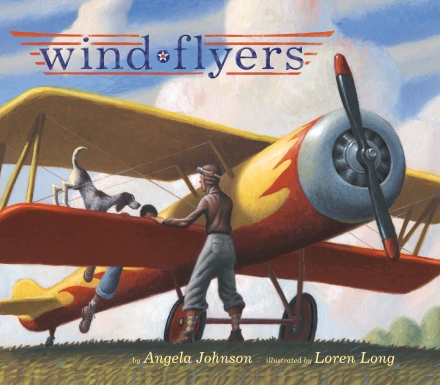About the Holiday
If you look back in history you see that people have always been fascinated with flight. The first kite was invented in 1000 BCE in China; around 400 BCE Archytas of Tarentum developed a steam-powered pigeon; and most people are familiar with the designs of flying machines that Leonardo de Vinci created in the late 1400s. An important discovery that led inventors in the right direction came in 1680 when an Italian mathematician determined that human muscles were incompatible with flight.
Zip ahead about 100 years and the first hot-air balloon flight was undertaken, which led to more and more complex technology, resulting in Wilbur and Orville Wright’s flight in 1903. From there, it seemed, the sky was the limit. Amelia Earhart became the first woman to complete a trans-Atlantic Ocean solo flight in 1932, and in 1947 Charles Yeager broke the sound barrier. But it’s astounding to think that from that modest 12-second first flight by the Wright Brothers to the first man in space—Soviet cosmonaut Yuri Gagarin—it took only 58 years! Today astronauts from countries around the world live and work in the International Space Station, and spacecraft are traversing deep space.
Wind Flyers
Written by Angela Johnson | Illustrated by Loren Long
With pride a young African-American boy tells the story of his great-great-uncle who was a Tuskegee Airman in World War II. His uncle was “a smooth wind flyer. A Tuskegee wind flyer…,” the boy says. He knows well his uncle’s history—how like a bird, his uncle believed he was born to fly. “With his arms flapping, he jumped off a chicken coop at the age of five,” and when he was only seven he soared from a lofty barn into a pile of hay. His first real flight came at the age of eleven, when he paid 75 cents to be a passenger with a barnstormer.
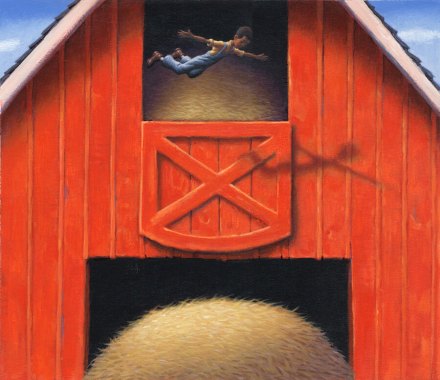
Image copyright Loren Long, courtesy of Simon & Schuster
Flying over lakes and fields, his uncle felt as if he were in Heaven, among clouds “like soft blankets, saying, ‘Come on in, get warm. Stay awhile and be a wind flyer too.’” The experience changed him forever. In fact he “cried when they landed because then he knew what it was like to go into the wind, against the wind, beyond the wind.” As a young adult his uncle contributed his dream and his skills to the World War II effort, becoming a Tuskegee Airman, one of the first black pilots in the United States military.

Image copyright Loren Long, courtesy of Simon & Schuster
As the pair sit in the uncle’s barn, surrounded by his military uniform, leather jacket, and other memories of his flying career—after the war to continue flying he became a crop duster—the pair look through old photographs, seeing once more those young and brave pilots—the Tuskegee wind flyers. Planes are different now, Uncle says, but the clouds remain the same. The boy and his uncle climb to the highest point of the uncle’s barn to watch the jets—and in those moments they once more become the smooth wind flyers, flying into the wind and beyond.
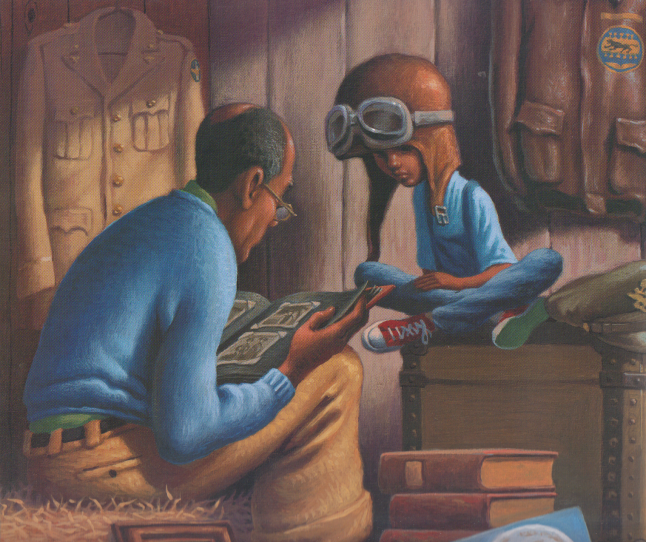
Image copyright Loren Long, courtesy of Simon & Schuster
In her soaring, rhythmic language, Angela Johnson captures the dreams and yearning of a young boy whose greatest desire is to fly among the clouds. Her combination of straight narration with lyrical lines as he joins the Tuskegee Airman in World War II enhances the sense of achievement and pride the young pilots felt. The structure of the story is well chosen, as relating the uncle’s life from childhood through old age through the eyes of his nephew strengthens the themes of strong familial relationships as well as shared dreams across generations.
Loren Long gives Wind Flyers additional power with his strong, vibrant paintings. Two-page spreads provide a sense of the vastness of the skies that so enticed the young would-be pilot. Even the clouds echo the emotion of the page—fluffy, floating, and alive in the flight scenes while linear, flat, and stationary when the plane and the uncle are earthbound. Realistic portrayals of the boy, his uncle, and the other Tuskegee Airmen are reminiscent of the WPA murals of the 1940s while still setting this book firmly in today for a new generation.
Wind Flyers is a wonderful book to share with aviation buffs, budding historians, and dreamers of all types and would make a welcome thoughtful book for quiet story times.
Ages 4 – 9
Simon & Schuster Books for Young People, 2007 | ISBN 978-0689848797
To learn more about Angela Johnson‘s books for all ages, visit her website!
View a gallery of artwork for picture books and other media by Loren Long, visit his website!
National Aviation History Month Activity
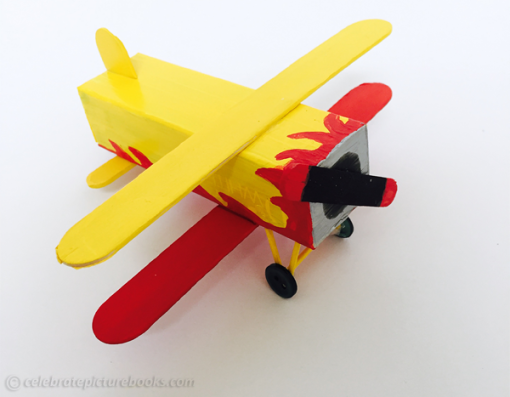
Head in the Clouds Box Biplane
If you love airplanes and flying, you’ll have fun making your own plane from recycled materials! Use your creativity to decorate your plane while you imagine yourself flying through the clouds on a beautiful day. Younger children will have fun sharing this activity with an adult or older sibling too!
Supplies
- Travel-size toothpaste box
- 3 6-inch x 1/2-inch craft sticks
- 2 2 1/2-inch x 7/8-inch mini craft sticks
- 5 Round toothpicks, with points cut off
- Paint in whatever colors you like for your design
- 4 small buttons
- 2 mini buttons
- Paint brushes
- Strong glue or glue gun
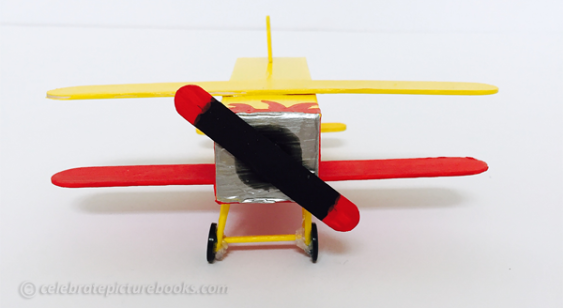
Directions
- Empty toothpaste box
- Paint toothpaste box and decorate it
- Paint the craft sticks and 5 toothpicks
- Paint one small craft stick to be the propeller
- Let all objects dry
To assemble the biplane
- For the Bottom Wing – Glue one 6-inch-long craft stick to the bottom of the plane about 1 inch from the end of the box that is the front of the plane
- For the Top Wing – Glue the other 6-inch-long craft stick to the top of the plane about 1 inch from the front of the plane
- For the Tail – Glue one mini craft stick to the bottom of the box about ¾ inches from the end that is the back of the plane
- For the Vertical Rudder – Cut the end from one of the painted 6-inch-long craft sticks, glue this to the back of the box, placing it perpendicular against the edge and half-way between each side
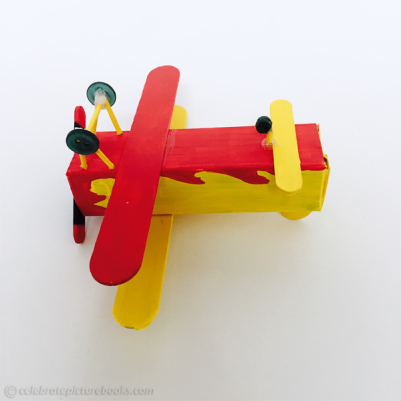
To assemble the front wheels
- Cut 4 painted toothpicks to a length of ¾-inches long
- Cut one painted toothpick to a length of 1-inch long
- Glue 2 of the 3/4-inch toothpicks to the back of 1 button, the ends of the toothpicks on the button should be touching and the other end apart so the toothpicks form a V
- Repeat the above step for the other wheel
- Let the glue dry
- Glue the 1-inch long toothpick between the wheels at the center of each wheel to keep them together and give them stability. Let dry
To make the back wheel
- Cut two ¼-inch lengths of painted toothpick and glue them together. Let dry
- Glue two mini buttons together to form the back wheel. Let dry
- Glue the ¼-inch toothpicks to the mini buttons. Let dry
- Glue these to the bottom of the plane in the center of the box directly in front of and touching the tail
Display your biplane!
Picture Book Review
Picture Book Review

